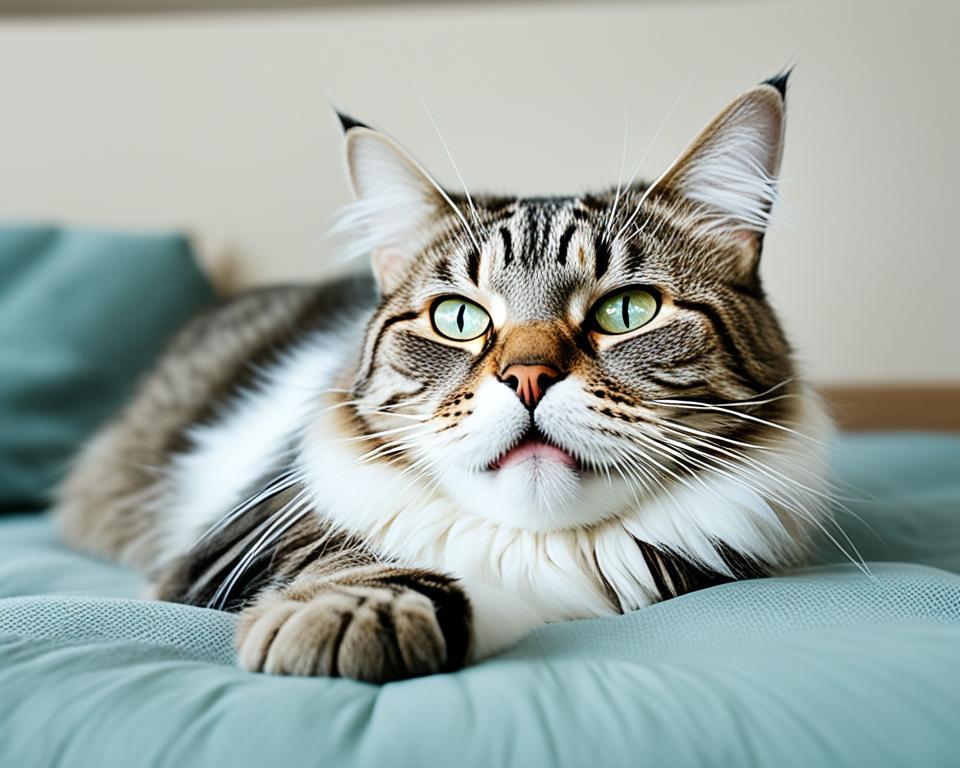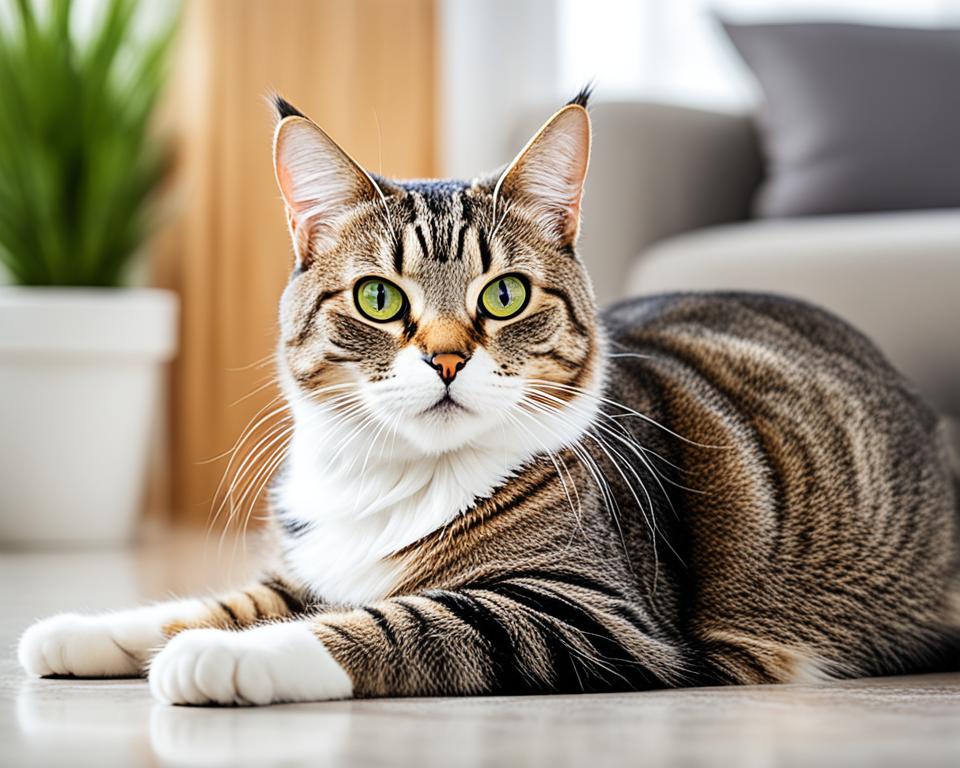As a cat owner, I find it hard to spot health issues in my furry friends. Cats are great at hiding when they’re not feeling well. That’s why I want to share some important things to watch for in your cat’s behavior and looks.
Cats often show signs of illness in small ways. I’ve learned to watch for changes in how they eat or drink, sudden weight loss, and odd grooming habits. If my cat hides more or sleeps a lot, it could mean they’re sick.
Regular vet visits are key for catching health problems early. I make sure to take my cat for yearly check-ups. These visits can spot issues before they get worse. Cats can face many health problems, like urinary tract diseases or diabetes.
Knowing about these issues helps me take better care of my cat. It’s important for any pet owner to know this. If you’re unsure about your cat’s health, always talk to a vet for advice.
Understanding Feline Health: An Overview

As a cat owner, I’ve learned that keeping your cat healthy is more than just feeding and petting. It’s about giving them the right food, making sure they get enough exercise, and taking care of their health before problems start. Here are some important tips to keep your cat happy and healthy.
Cats can face many health issues as they grow older. From what I’ve seen, they often deal with stomach problems, parasites, and long-term diseases. Let’s look at some facts:
| Health Issue | Prevalence | Key Facts |
|---|---|---|
| FLUTD | 3% of vet visits | Stress, diet changes can trigger |
| Lymphosarcoma | 30% of cat cancers | Linked to feline leukemia virus |
| Behavioral Issues | 27% of shelter surrenders | Aggression is a leading cause |
Preventive care is key to keeping cats healthy. I make sure my cat goes for regular check-ups, gets their shots, and eats well. This helps find problems early and keeps them healthy overall.
“An ounce of prevention is worth a pound of cure.”
Every cat is different. Their health needs change based on their age, breed, and lifestyle. By knowing these basics, we can give our cats the best care and enjoy many happy years together.
Common Cat Health Problems

As a cat owner, I’ve learned that our feline friends can face various health challenges. Let’s explore some common issues that might affect your kitty’s well-being.
Feline Lower Urinary Tract Disease (FLUTD)
Cat urinary problems, especially FLUTD, are more common than you might think. This condition affects about 1-3% of cats seen by vets. Overweight and older cats are most at risk, regardless of gender. Symptoms include frequent urination, straining, and blood in urine. To prevent FLUTD, ensure your cat stays hydrated and maintains a healthy weight.
Feline Diabetes
Feline diabetes is a serious concern, especially for obese male cats. They’re up to four times more likely to develop Type II diabetes. Watch for increased thirst, weight loss, and lethargy. A balanced diet and regular exercise are key to prevention.
Respiratory Infections
Cat respiratory issues, like cat flu, can be particularly troublesome. Caused by viruses such as Herpesvirus and Calicivirus, these infections often lead to sneezing, runny noses, and sore eyes. Kittens are especially vulnerable, with symptoms lasting 10-14 days on average.
Dental Disease
Dental health in cats is often overlooked, yet it’s crucial. By age 3, up to 90% of cats may suffer from dental disease. Regular check-ups and proper dental care can prevent issues like plaque, tartar, and tooth decay.
| Health Issue | Prevalence | Key Prevention |
|---|---|---|
| FLUTD | 1-3% of vet visits | Hydration, weight control |
| Feline Diabetes | 1 in 200 cats | Balanced diet, exercise |
| Respiratory Infections | Common in kittens | Vaccination, stress reduction |
| Dental Disease | 90% by age 3 | Regular dental care |
Parasitic Infestations in Cats

I’ve seen many parasitic problems in cats. These tiny pests can cause big health issues if not treated. Let’s look at common parasites and how to keep our cats safe.
Fleas: Prevention and Treatment
Cat fleas are a big problem, causing skin irritation and even anemia. Cats with fleas scratch a lot and have red, irritated skin. Look for tiny black specks, called flea dirt, as a sign.
Preventing fleas is important. Use monthly treatments or flea collars. Groom your cat with a flea comb to catch these pests early.
Tapeworms: Causes and Symptoms
Feline tapeworms come from fleas. These worms can be up to two feet long! Look for worm segments in feces or around the anus. Weight loss and a dull coat are also signs.
Other Common Parasites
Roundworms and hookworms are common in cats too. They can cause serious health problems, especially in kittens. Deworming regularly is key to preventing these parasites.
| Parasite | Prevalence | Symptoms |
|---|---|---|
| Roundworms | 25-75% | Poor growth, pot-belly appearance |
| Hookworms | 10-60% | Anemia, weight loss |
| Tapeworms | Varies | Visible segments in feces, weight loss |
Keeping a cat healthy means catching problems early. Regular check-ups and prevention help keep parasites away.
Digestive Issues in Cats
Gastrointestinal problems in cats are more common than you might think. Did you know that 35% of these issues are caused by intestinal parasites? Cat vomiting and feline diarrhea are often the first signs of trouble. I’ve seen many cats struggle with hairballs, which affect up to 10% of our feline friends. These can lead to digestive discomfort and even blockages if not addressed.
Foreign objects are another culprit, causing complications in about 8% of cats. It’s crucial to keep an eye on what your cat might be swallowing. Inflammatory bowel disease, affecting 2-3% of cats, can cause chronic vomiting and diarrhea. Food allergies are also a concern, impacting 6% of cats, with beef, fish, and chicken being common triggers.
If you notice your cat showing signs like bad breath, reluctance to eat, or weight loss with a painful abdomen, it’s time to visit the vet. Early intervention is key in treating digestive issues. Remember, persistent gastrointestinal problems can lead to dehydration, so don’t wait to seek help. With proper care and attention, we can keep our feline companions happy and healthy.

